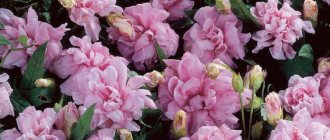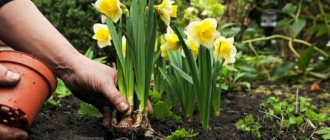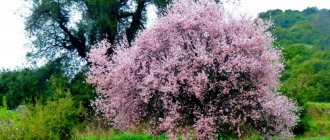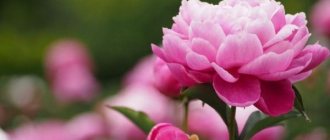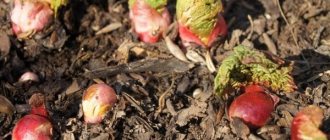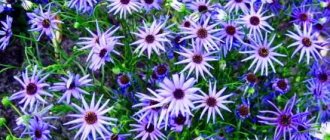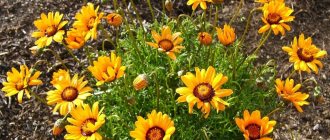What does a begonia flower look like?
The homeland of the plant is the West Indies. There, the French botanist Charles Plumier discovered this flower. He named it in honor of the organizer of that expedition - Monsieur Begon. Habitat: tropics and subtropics of Africa, Asia, South and North America. The humidity in those parts is high, so the flower is demanding when it comes to watering.
This is what begonia looks like
Perennial garden begonia, like annual begonia, is found in the form of vines, shrubs and subshrubs. Most of them are small - reaching a maximum height of 20 cm. There are also tall ones, stretching up to 35 cm. Flowering is abundant, the buds cover the entire bush.
The color and shape of the leaves depend on the variety. They come in green, olive, burgundy and pink, sometimes with pearlescent dots or streaks. The leaves of some varieties are hairy, like Begonia metallica or Begonia griffithiana.
Homeland of the plant
Begonia is a plant that experiences tropical and subtropical climates. It is common in the countries of Southeast Asia, America, and Africa. You can also find some specimens on the island of Madagascar, where begonia feels good in open ground.
May have different sizes and shapes. For example, the smallest specimen will be only a couple of centimeters, and the largest will grow up to three meters in height.
Due to its unique ability to adapt to a variety of conditions, it can be found both in forests with high humidity and on cold rocks in the gorge.
Varieties of garden begonia and their names with photos
The plant comes in outdoor and indoor types. The former are used in landscape design, where three varieties of begonias are popular:
- Tuberous begonia (B. tubergybrida)
Tuberous begonia (B. tubergybrida)
Notable for its long flowering (from early July to late November). The color can be scarlet, bright red, soft pink, white, yellow. Other features of the variety:
- Maximum height – 30 cm.
- Dioecious flowers with a diameter of 6-21 cm.
- Double, semi-double, smooth inflorescences (similar to carnations, camellias, roses).
- Durable stem.
- Fleshy tuber.
- Ampelous begonia (B. tubergybrida pendula)
Ampelous begonia (B. tubergybrida pendula)
Long bushy shoots grow up to 80 cm. They are covered with caps of flowers of various shades.
- Ever-blooming begonia (B. semperflorens)
Ever-blooming begonia (B. semperflorens)
The variety includes many hybrid varieties. This begonia is grown in flower beds, parks and squares. Characteristics:
- The height of the shoots is 15-20 cm.
- The flowers are white, pink or bright red.
- The leaves are small, smooth, oval in shape. Their color varies from green to brownish.
- Unpretentious to external conditions.
Gardeners' secrets for lush flowering
In order for begonia to decorate a flowerbed and delight with many buds, the plant must be regularly fed with complex fertilizer, dried leaves must be picked off, irrigated on time, but not overwatered, disease prevention must be carried out, and protected from pests. You need to make sure that the ground under the exotic flower is not strewn with buds or petals, as this is fraught with the development of rot.
Gardeners recommend watering the tropical guest not only with mineral and soft water, but also with infusions prepared from onion peels and garlic shoots.
Flowers begin to fall off when there is excess moisture and high temperature. In this case, you need to shade the begonia and reduce the frequency of irrigation. When optimal conditions are created, the buds do not fall off, and the plant is covered with white, pink and scarlet flower caps.
How to plant in open ground
The street landscape is decorated with annual varieties. The origin of the flower is tropical, so even short frosts will destroy it. Given this feature, the garden plant is planted only in warm weather. The best time is from the end of May or the beginning of June, when there are no sharp cold snaps (in the northern regions you will have to wait until the beginning of July).
It is recommended to use seedlings that have already buds. It is either grown in advance in a greenhouse or bought in a store. The benefit of this solution is that the plant will bloom immediately in the year of planting. It is important to consider several nuances:
- It is better to buy young tubers with a diameter of up to 6 cm.
- If the tubers are purchased after summer, then they are placed in damp sand and stored until spring at a temperature of 3-7 ° C (refrigerator or cellar). Otherwise, they will dry out and then will no longer be suitable for growing.
- No mold. If some areas of the tuber are affected, then it is immersed in a 1% hydrogen peroxide solution for 3-4 hours.
The process of planting begonia tubers
Site selection and soil preparation
Garden begonia is a light-loving plant, but direct sunlight is destructive for it. The flower should be planted in shady places. The area should be protected from winds and well lit. It is advisable that a shadow falls on it during the midday hours.
The soil for the plant must be fertile, with good air permeability and a slightly acidic reaction (pH - 5.0-6.0). Before planting, the soil is fertilized with ash and humus, and then loosened. Drainage made of pebbles or expanded clay is mandatory - this is protection against rotting of the root system that occurs due to waterlogging with groundwater.
Planting begonias in open ground
A garden plant is planted according to the following rules:
- Dig a separate hole for each flower. Dwarf varieties are placed according to a pattern of 9-13x15 cm, and tall varieties - 35x45 cm.
- The base of the shoot is carefully buried 2-3 cm into the ground.
- The soil surface is covered with humus or wood ash.
- At night, the seedlings are covered with film for 2-3 weeks after planting. This way they will survive the cold and take root in a permanent place.
Begonia planting process
Plant care
Caring for begonias includes the same basic measures that other perennial garden flowers require. Namely:
- watering;
- fertilizer;
- loosening the soil;
- weed control;
- preparation for the winter period.
Begonia is moisture-loving, and drought is destructive to flowers. In hot summers in the absence of rain, watering is carried out every other day. This care is combined with loosening the soil and applying fertilizers. Then it is useful to mulch the soil. This will bring threefold benefits: it will retain moisture in the soil, fertilize the soil and prevent weeds from breaking through.
Advice. It is recommended to water in the evening or early in the morning, before sunrise.
In autumn, begonia stops forming and opening buds. This serves as a signal that the time will soon come to remove the tubers from the soil and send them for winter storage, in order to then plant them again in the new season.
Begonia fimbriata
Caring for dug up planting material involves clearing the soil and drying it for about 2 weeks. Afterwards it is hidden in containers with sand and sent to the basement for storage.
In spring, these tubers can be used to propagate begonias. New plants are grown from cuttings.
How to care for begonia
Caring for a garden flower includes:
- Watering in the morning or evening. Warm water is infused for a day in an open container, and then poured under the tubers. It is important to prevent excess moisture, otherwise you will have to remove the rotten roots and replant the flower in new soil. The interval between watering in spring and summer is 3-5 days. If the heat sets in, this break is shortened so that the soil around the plant is constantly moist. Flowering begonias are watered daily, and after this period they return to normal mode. From about the beginning of October, watering is reduced to once a week.
- Loosening. Carefully apply to a depth of 1-2 cm immediately after watering. This maintains soil aeration, which will save the garden plant from rotting due to stagnant moisture.
- Fertilizer. It is necessary to feed begonia with microelements, including phosphorus and potassium.
- Fertilizers are applied once a week, starting from the moment of flowering (every 12-15 days).
- In winter, fertilizing is reduced to once a month.
- Weeding. Weeds near the plant must be removed promptly.
- Temperature control. In spring and summer, the flower needs 20-22°C, and in winter – at least 15-18°C.
- Air humidity. It must be at least 50%. It is strictly not recommended to spray garden begonia - this will damage its decorative properties. Droplets of water remaining on the leaves and flowers are fraught with the appearance of brown spots.
How to care for begonia
Improper care leads to complications:
- Dry leaf edges due to low air humidity (less than 50%).
- Poor, short-term flowering due to lack of fertilizer or dim lighting.
- Brown or brown spots on foliage. They appear when exposed to droplets of water or direct sunlight.
- Elongated shoots. Caused by a lack of lighting.
- The leaves curl and change color due to an excess of nutrients.
Fertilizer and feeding
Garden begonia spends a lot of energy on lush flowering, so it is regularly saturated with:
- phosphorus-potassium fertilizers;
- complex nitrogen fertilizing (only in spring for deciduous varieties).
Phosphorus-potassium fertilizers are used once every two weeks (every 12-15 days), starting from the moment of flowering. The drug “Bona Forte” is suitable, 10 ml of which is diluted in 1.5 liters of water. Other analogues can be used:
- "Good Power";
- "Biopon";
- "Fertika Lux";
- "Mr. Color"
Fertilizers for begonia
Nitrogen fertilizers increase the growth of green mass, so they are used to fertilize deciduous varieties. It is important to remember that such products can inhibit the development of buds. They are used with the same frequency as phosphorus-potassium fertilizers, but only during the spring. Well proven:
- “Bona Forte for violets and begonias”;
- "Azovit".
Fertilizers are applied in the morning or evening, after moistening the soil 2 hours before the procedure. Fertilizers should not get on the plant, otherwise the chemicals may harm it (the leaves will turn yellow or wither). It is important to observe the measure for each drug - an excess leads to toxicosis and death of the flower.
Reproduction methods
Growing new begonias is possible in three ways:
- dividing tubers (only for tuberous species);
- seeds (suitable for decorative deciduous and ever-flowering varieties);
- vegetative method (stem cuttings or leaves).
The conditions for propagating a garden flower are similar to caring for adult plants:
- Temperature. In spring and summer it should be 20-22°C.
- Lighting. Seedlings are placed on a window facing southeast or southwest. They need bright, indirect lighting. If the shoots are thin, then the seedlings are additionally illuminated with a lamp.
- Watering. The frequency is the same as when caring for adult begonias. Drying of the soil or stagnation of moisture is unacceptable.
- Air humidity. Must be at least 50%
- Ventilation. Seedlings are regularly hardened off with fresh air.
- Rest mode. It lasts from November to February. The optimal temperature is not lower than 15°C, watering is reduced to once a month, and fertilizing is stopped altogether.
Sowing seeds for seedlings
Begonia on seedlings
Garden Begonia requires a substrate of black soil, leaf soil and sand (1:4:1), mixed with perlite. The soil should be slightly acidic (pH 5.0-6.0). The drainage layer is made of pebbles or expanded clay. Sow seeds at the end of February, when solar activity increases. First you will need a tray for seedlings:
- The seeds are scattered evenly over the moistened substrate. There is no need to sprinkle them - just roll them so that they have enough light.
- The seedlings are covered with glass or plastic film to maintain humidity.
- Seedlings are watered regularly to prevent the soil from drying out. Do this with a spray bottle - this way there is less risk of washing off the seeds.
- The glass or film is raised daily for half an hour when the first shoots appear. This will happen a week after planting.
- The coating is completely removed after 2 weeks.
- The seedlings are carefully picked out in the 3rd week after planting (when the third true leaf appears). The seedlings are transplanted one at a time into small cups, following a 2x2 cm pattern. Tuberous varieties are planted a second time (3x4 cm) and a third time (6x6 cm).
- Seedlings are transplanted into pots or containers 1-1.5 months after planting.
Reproduction by tuber division
Suitable for old or heavily overgrown flowers. Reproduction of tuberous begonia is carried out in the spring at home:
- Prepare a substrate from black soil, leaf soil and sand (1:4:1), mix it with perlite.
- Select the material to be divided. The plant must be at least 2 years old. The buds need to be sprouted - sprouted ones will not do.
- Selected tubers are washed.
- The locations of the incisions are marked so that there is a kidney in each such area.
- The garden begonia tuber is divided with a sharp knife.
- The cut areas are sprinkled with ash or charcoal. The damage will heal faster and the risk of infection will be reduced.
- The roots are planted in a pre-moistened substrate, deepening them to 3 cm.
- The soil is filled in so that the buds remain on the surface.
- The planting material is covered with film and ventilated daily for half an hour.
Green cuttings
The first method is to use young shoots from the parent plant:
- Cuttings are taken from the mother tubers. The optimal length of shoots is 8-12 cm, and the number of buds is 2-3. It is advisable to leave no more than two leaves on each sprout.
- The cuttings are processed. The cuts are lubricated with charcoal or activated carbon, after which the shoots are dried.
- Option 1 - the sprouts are rooted in water. The lower parts of the cuttings are placed in a vessel with warm moisture. It is advisable to use a dark container - this way the shoots are better protected from UV rays, and the liquid deteriorates more slowly. Then they simply wait for the root to grow to at least 2 cm. If rot appears on the cut, then the affected area is removed, and the cutting itself is dried and transferred to fresh water.
- Option 2 - the sprouts are rooted in the substrate. First, the cut of the cutting is treated with heteroauxin, root or other analogue - these agents will accelerate the development of roots. Next, prepare boxes, pots or cups with a soil mixture of peat, leaf soil and sand (1:2:1). The sprouts are planted in these containers, carefully buried 1-2 cm into the soil. They are covered with a jar and then placed in a greenhouse or closed in a transparent container. The substrate is constantly kept moist. The seedlings are ventilated daily for 2-3 minutes from the moment steam forms inside the greenhouse. Next, they wait for the first leaves to appear on the shoots.
- Rooted cuttings are planted in a permanent place.
Prepared begonia cuttings for planting
The second method is leaf propagation:
- Collect material from the mother bush. You need to choose a healthy, whole and rich leaf with pronounced veins.
- It is cut into pieces so that a part of the central vein remains on each of them.
- The cuttings are planted in containers with a substrate of peat, leaf soil and sand (1:2:1). This is done either vertically (the plates are buried 1 cm) or horizontally (the pieces are pressed to the ground with a vein and their edges are sprinkled with earth).
- The containers are placed in a greenhouse. The soil is regularly kept moist. The seedlings are ventilated daily for 2-3 minutes from the moment steam forms inside the greenhouse.
- Wait 3-4 weeks after planting, when young stems appear and leaves form on them.
- Transfer them to the windowsill to provide diffused light.
- Plants on which 4-5 leaves have formed are transplanted to a permanent place.
Begonia leaves in a container
Outdoor begonia: planting and care
Perennial garden campanula - planting and care
The flower is successfully grown outdoors in open ground. Begonia is planted in beds in the form of tubers, cuttings or young seedlings.
Outdoor pot with plant
Planting tubers
The tuber should be young, up to 4-6 cm in diameter, with live buds - “eyes”. Before planting, the shoots are inspected and dry roots are removed. You can carry out a small disinfection - soak the tuber in a low-concentrated solution of hydrogen peroxide for about half an hour.
If mold is found on the planting material, it is carefully removed with a soft bristle brush and soaked in a disinfecting solution.
On a note! In gardening stores you can purchase a special liquid to protect tuberous plants from pests.
Begonia tubers are planted in March-April in planting containers or in May-June directly in open ground. One tuber can produce several plants. The separated tuber lobes or sprouts from the tuber are planted in small individual containers (cups) and sprinkled with soil on top. After rooting, which usually does not take much time, the seedlings are transferred to open ground.
In winter, the tubers are stored in moistened sand in a cool place, such as a cellar. If there is no such room, then a refrigerator shelf will do. From time to time you need to add water to the sand, but do not fill the tuber, otherwise it will begin to rot.
Begonia cuttings
With the cutting method, the tops of healthy flowering plants are cut off. There should be approximately three pairs of leaves left on the stem; the buds and inflorescences are removed. The lower sections are treated with a substance that stimulates root growth.
For rooting, cuttings are placed in peat pots, which are then planted in open ground. Such containers are organic products; their walls are made of peat-wood pulp with the addition of chalk (high-moor peat, up to 70% of the composition). This is necessary to maintain the integrity of the root system. The soil mixture for pots is slightly acidic, with a high content of peat and nutrients. You can purchase ready-made soil for begonias.
In May, containers with cuttings are placed in the ground and covered with transparent plastic bags. The outside temperature should be no lower than 18-22 °C.
On a note! Watering is carried out moderately, liquid fertilizing is applied, no more than once a week, in accordance with the manufacturer’s instructions.
When the plants get stronger, the bags are finally removed.
The interval between young plantings should be approximately 15-20 cm. It is recommended to plant begonias of different shades: this will create a variegated flowering carpet.
Carpet flowering
How to grow a bush from seeds
The procedure is carried out in February. Take a container with soft peat soil (a low seedling box), lay the seeds on the surface, there is no need to bury them deeply. For better adhesion to the ground, just spray with a spray bottle. The container is covered with a transparent lid to create conditions like in a greenhouse. Flower growers often use food-grade plastic containers with a lid attached to the side for these purposes.
Seeds are checked and aerated daily. When the sprouts appear, they are no longer covered with a lid. Young begonia plants are planted in a flowerbed when they reach a height of five to six centimeters. When replanting, you need to pay attention to the roots: in healthy specimens they will already be quite long and branched.
Note! Propagation from seeds is not the easiest way and requires some skill and a lot of patience, but in gratitude the gardener will receive high germination and flowering in the first year.
What to do with begonia in the fall
The plant needs to be prepared for wintering. Garden begonia in its native conditions is an evergreen perennial that blooms continuously even in winter. Only the air temperature must be at least 15°C. Otherwise, the plant will lose its decorative effect, the leaves will dry out and fall off.
The domestic winter is destructive for begonia, so it is prepared for cold weather in the fall. This is done between September and October:
- All stems are cut off almost to the root, leaving only 2-4 cm of stumps.
- Dig up and dry the tubers. Do this in a ventilated room or in the fresh air, but not in the sun.
- Shake them off from dirt and place them in a container with sand (cardboard box, box).
- Tubers are stored in a cool place (3-7°C) until spring.
Trimmed begonia
Garden begonia: general information
Begonia (lat. Begonia) is part of the large Begonia family. The genus itself has more than 1,500 varieties and hybrid varieties, which indicates the popularity of the flower and the interest of breeders in it.
Begonia bush in the garden
Garden begonia is a decorative flowering perennial shrub or subshrub native to tropical humid regions and drier mountainous areas. Gardeners value begonia for its long flowering time, which often lasts until November. Its types differ in the height of the bush, the shape and color of the flowers.
Popular garden varieties:
- Golden ball;
- Firemeyer;
- Minion.
The color palette of the buds is very rich: white, pink, red, crimson shades decorate flower beds and verandas. Begonia flowering can be very dense - under favorable conditions, the flowers cover all the greenery around.
Decorative deciduous species of begonia are also quite popular, especially variegated (variegated) varieties. However, gardeners prefer to grow flowering varieties in flower beds, the choice of which is wide.
The roots of garden begonia are tuberous or thickened tuberous. Propagation of the plant is possible by dividing the tuber, cuttings, seeds and leaves. The height of mature bushes is usually 20-30 cm.
Additional information : caring for begonia outdoors is not difficult, but it requires patience and consistency: the plant does not forgive mistakes and simply stops blooming.
Disease and pest control
The plant should be regularly inspected for the absence of diseases and parasites. The main remedy for flower health is proper care after planting. Excessive or insufficient watering, inappropriate soil composition, lack of light - all these factors provoke illnesses.
Outdoor begonia often suffers from the following fungi and pests:
- Powdery mildew. The infection covers the plant with a white coating. It looks like flour and is easily washed off, but it always reappears. The growth of begonia stops, and its affected parts dry out and fall off. Fungicides Rovral, Morestan, Fundazol, Hom will help get rid of the disease.
- Gray rot. A fungal disease that develops in warm, rainy weather. It appears on the leaves in the form of watery spots with a gray coating. They quickly develop into rotting brown sores. Inflorescences with buds become slimy, shoots break, and leaves curl and darken. It is treated with Bordeaux mixture or fungicides Skora, Ordana, Previkura.
- Aphid. It settles on the inside of leaves and feeds on plant juices. These pests form colonies that can destroy entire plantings. They are destroyed with insecticides Aktara, Fitoverm, Decis, Aktellik.

